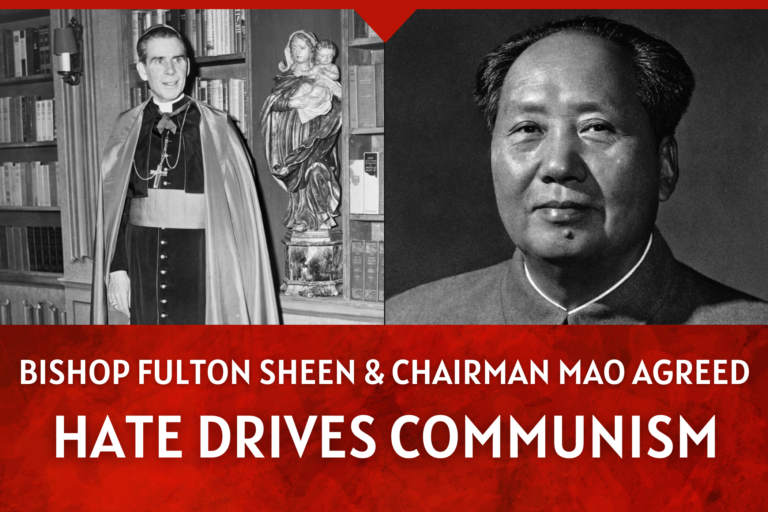Note: The following is excerpted
from Steven Mosher’s book, Population
Control—Real Costs, Illusory Benefits.
The first population bomber of the modern age
was, by profession at least, ill-suited to the task. The Rev. Thomas
Malthus, Anglican clergyman, predicted in 1798 that there would be
standing room only on this earth by the Year of Our Lord, 1890.
A London talk by
Benjamin Franklin had inflamed Malthus’ imagination. The
American polymath had proudly proclaimed to his English audience that
the population of their former colonies was growing at a rate of 3
percent a year. The good Parson, who fancied himself something of a
mathematician, knew that this meant that America’s population
was doubling every 23 years or so. He pondered this remorseless
geometric progression during the long walks he was accustomed to take
in the English countryside, becoming increasingly concerned about the
staggering numbers—2, 4, 8, 16, 32, 64—that would soon
result. He imagined the boroughs filling up with people, until every
available nook and cranny was choked with human misery. And how
could this coming hoard of humanity possibly be fed, he wondered?
How could sufficient grain be grown in the green fields he was
passing, even if every moor, hedgerow and woodland was brought under
cultivation? An arithmetic increase in the food supply—2, 4,
6, 8—was the best that could be hoped for. But with men
multiplying geometrically and food only arithmetically, the number of
people would inevitably outstrip the food supply. It was perhaps the
very simplicity of the Parson’s notion that gave it such a
strong grip on his mind. Better minds than his would soon fall prey
to the same delusion.
Malthus published his speculations in 1798 in a
tract called An Essay on the Principle of Population.
Despite its scholarly sounding title, this was the original
“population bomb.” It contained no images of exploding
ordinance (these would be reserved for our less genteel age), but
like its latter-day imitators it aroused great public concern by
painting a picture of imminent catastrophe brought on by the
unchecked growth in human numbers. Such a fate, Malthus argued,
could only be avoided by stern, even pitiless, measures. The
problem, as he saw it, was that the death rate in England was in
marked decline. Before the advent of modern means of sanitation and
medicine roughly 40 out of every thousand people had died each year.
But as the Industrial Revolution spread, it brought better housing
and nutrition for the poor, and provided the means for public
authorities to underwrite public health and sanitation measures. The
death rate had dropped to 30 per thousand and was still falling.
Malthus proposed to undo all this:
All children born, beyond what would be
required to keep up the population to a desired level, must
necessarily perish, unless room be made for them by the deaths of
grown persons. . . . Therefore . . . we should facilitate, instead of
foolishly and vainly endeavoring to impede, the operations of nature
in producing this mortality; and if we dread the too frequent
visitation of the horrid form of famine, we should sedulously
encourage the other forms of destruction, which we compel nature to
use. Instead of recommending cleanliness to the poor, we should
encourage contrary habits. In our towns we should make the streets
narrower, crowd more people into the houses, and court the return of
the plague. In the country, we should build our villages near
stagnant pools, and particularly encourage settlements in all marshy
and unwholesome situations. But above all, we should reprobate
[I.e., reject] specific remedies for ravaging diseases; and restrain
those benevolent, but much mistaken men, who have thought they were
doing a service to mankind by projecting schemes for the total
extirpation of particular disorders.1
These were strange,
almost diabolical, views for a member of the Christian clergy to
hold. Were his emotions in synch with his intellect? Did
Malthus really mourn over baptisms, while celebrating funeral rites
with a particular zest? His population control measures were
denounced by many of his fellow Christians, who rejected them as an
offense against charity, not to say common sense. Karl Marx and
Frederick Engels weighed in as well, damning his theories as an "open
declaration of war of the bourgeoisie upon the proletariat," and
Malthus himself as a "shameless sycophant of the ruling classes,
terrified by Europe’s burgeoning working class and the French
Revolution.2
His theories were embraced, however, by members of the British upper
class. An increasingly barren lot themselves, they feared that the
poor were becoming too prolific, not to mention too powerful at the
polls and in the marketplace. These Malthusians, as they came to be
called, helped to ensure that their founder’s “Essay on
Population” was a commercial success, appearing in no fewer
than six editions from 1798 to 1826. Population horror stories have
sold well ever since.
Life spans lengthened and general
health improved throughout the nineteenth century, but Charles Darwin
gave the Malthusians something new to brood over. Not only were the
poor too prolific, but by having all those children—most of
whom, to make matters worse, now survived childhood—they were
rapidly dumbing down the population. For the prosperous and
privileged, who found themselves increasingly outnumbered by the
great unwashed, this was the “survival of the fittest” in
reverse. This view was given intellectual respectability by Francis
Galton, a cousin of Darwin himself. In his Inquiries into Human
Faculty and Its Development, Galton gave a pseudo-scientific
gloss to what he saw as the declining genetic stock of the nation.
To counter this “dysgenic” trend, he proposed an active
policy of “eugenics,” a word he coined meaning “good
births.” Eugenics would encourage more children from the fit,
and fewer—or no—children from the unfit, with the
ultimate goal of engineering the evolutionary ascent of man.
Such views were eagerly
embraced by the secular humanists of the early twentieth century,
who—as in our day—were busily thinking of ways to improve
the natural man at the same time that they reduced his numbers.
Malthus, in particular, proved a fit precursor to Planned Parenthood
founder Margaret Sanger, who also opposed helping the poor.
Philanthropy, she wrote, following the good Reverend, merely bred and
perpetuated “constantly increasing numbers of defectives,
delinquents and dependents.”3
Such aid supported, at a “terrific cost to the community,”
a “dead weight of human waste.”4
But while Malthus was
content to wait for plague, pestilence, and putrification to check
human numbers (he opposed contraception and abortion), Sanger, not
one for half-measures, wanted to stop the “unfit” from
conceiving children in the first place. She stated forthrightly, “We
cannot improve the race until we first cut down production of its
least desirable members.”5
She hoped to accomplish this aim through the promotion of birth
control, but sterilization was a good option for those who couldn’t
or wouldn’t contracept. The government should get involved,
she believed, in providing a monetary incentive to coerce “the
ever increasing and numerous dependent, delinquent and unbalanced
masses” into being sterilized.6
“[A]sk the government to first take off the burdens of the
insane and feeble-minded from your backs,” she urged.
“Sterilization for these is the remedy.”7
Setting up the American
Birth Control League (as Planned Parenthood was first called), Sanger
sought to put her beliefs into action.8
To ensure “the elimination of the unfit,” she opened
birth-control clinics in America targeting the poor and the
disabled.9
Since the “unfit” lived abroad too, she spread her
eugenic beliefs throughout the world through population control,
which would ensure eugenic “quality” over mere population
quantity.10
Sanger often compared humanity to a garden, which required the
proper soil, fertilizer, and sunlight. "Do not forget this,"
she advised, "you have got to fight weeds."11
Her project attracted
the notice of those who considered themselves “fit”—and
who does not? In particular, however, the wealthy eugenicists of
Sanger’s day threw themselves into the eugenic project with
gusto. Sanger’s goal, in her own words, was “to create a
race of thoroughbreds.”12
Although she failed in this venture, as Hitler would fail even more
spectacularly after her, she did manage to round up quite a stable of
wealthy supporters. These with names like Rockefeller, Duke, Scaife,
Lasker, Sulzberger and Dupont, were easy marks for Sanger’s
arguments because they prided themselves on being the product of
superior bloodlines.13
In reality, most of Sanger’s “thoroughbreds” had
no great natural gifts; but for the accident of inherited wealth,
would have had merely middle-class prospects.
The Nazis took active
measures to purify the blood lines and improve the stock of the
“superior” Aryan race that went well beyond anything that
most eugenicists, even in their darkest moments, had envisioned. The
entire eugenics project went into eclipse, its advocates heatedly
denying that they had ever meant any such thing as Dachau, Auschwitz,
Bergen-Belsen, etc. For all that, population “quality”
remained a concern of the population control community and, carefully
disguised, would gradually over time creep back into its discourse.
When John D. Rockefeller 3rd drew up the draft charter of
the Population Council in 1954, for example, he included a paragraph
calling for the promotion of research so that “within every
social and economic grouping, parents who are above the average in
intelligence, quality of personality and affection, will tend to have
larger than average families.” Thomas Parran, a former surgeon
general and one of the few Catholics in Rockefeller’s circle,
objected that “Frankly, the implications of this, while I know
are intended to have a eugenic implication, could readily be
misunderstood as a Nazi master race philosophy.”14
The paragraph was quietly dropped.
But while Rockefeller
and others could easily be shamed into silence on the need to remodel
humanity, the horror of the Holocaust did not prevent them from
talking publicly about the continuing need to reduce human
numbers. After World War Two the U.S. and other developed countries
had sent many medical and aid workers overseas, and these
“benevolent, but much mistaken men,” as Malthus had
scornfully called them, were successfully eliminating many of the
infectious diseases which had long plagued the developing world.
While birthrates remained high, mortality rates were falling. The
populations of Latin America, Africa, and Asia were beginning a
period of rapid growth, as Europe and America had a few decades
before. With the help of Rockefeller and other men of great wealth,
controlling this growth was soon to be placed on the national agenda.
The Dilettante and the Huckster
Population growth seems
to arouse a primal fear in the wealthy, who somehow feel threatened
by the poor in their numbers. How else to explain the epiphany
experienced by John D. Rockefeller 3rd, grandson of oil
tycoon John D. Rockefeller and one of the wealthiest men in the
world, when he encountered the impoverished masses of the developing
world. A dilettante who had never held a steady job,15
he made extended journeys to Asia and Africa after the war. He came
away convinced that Western efforts to check what he saw as runaway
population growth must take precedence over economic development.16
He had found the cause that would consume his life. The peasant
societies of Asia, Africa and Latin America would never be the same.
Rockefeller’s efforts to win over
his fellow Rockefeller Foundation trustees to his new passion failed,
however. The majority believed (correctly, as history would show)
that Western technology, particularly American agricultural know-how,
would enable the peoples of the world to continue to feed themselves.
They rejected his controversial proposal to develop new birth
control methods and export these to the developing world. Denied
access to the family fortune, Rockefeller used his own money—a
sure sign of the true believer—to set up the Population Council
in 1952. The council posed, and still poses, as a neutral,
scientific organization, but its purpose in Rockefeller’s mind
was clear—to control global population growth. Although his
brother Nelson worried about the negative impact that these fringe
activities might have on his own political career, the family as a
whole supported the Rockefeller scion’s efforts, although
whether this was from shared conviction or simply to help him find
himself is not clear. The family attorney opined that “My own
feeling is that he [Rockefeller 3rd] has the time to do it
and that one of the things that he most needs is some activity which
will occupy his full time five days a week. It seems to me that if
he works at this conscientiously for a year or two he might make a
consequential dent in the problem . . .”17
In fact, he was to work as the President, later as the Chairman, of
the Population Council for the next quarter century. And as for the
“dent” in humanity that this produced, it was
considerable.
Unlikely
as it sounds, the dilettante threw himself into his new role as the
world’s first population control technocrat with almost
evangelical fervor. He gathered the best minds on the subject
together, and trained more, building a global network of population
experts who shared his anti-natal views. He funded research to find
easier, more reliable and, above all, more permanent
ways of contracepting and sterilizing the poor. He established
regional centers for demographic training and research in Bombay
(1957), Santiago (1958), and Cairo (1963), and national centers in
many countries, understanding these as stepping stones to instituting
full-scale population control programs. Such centers and the experts
they produced, explained Frederick Osborn, his right-hand man at the
Council, “stimulated recognition of the dangers of the
too-rapid growth of local population.”18
No doubt they did, since this was precisely why they were set up in
the first place.
As time went on, Rockefeller got
increasingly involved in “action programs” as well,
providing grants for the purchase of contraceptives, as well as
technical personnel to actually oversee their distribution in
developing countries. He helped to set up national family planning
programs in South Korea, Malaysia, Hong Kong, Ceylon, and elsewhere.
But the most important thing that he did, using his own funds and
those of like-minded super-rich, was to work quietly behind the
scenes to help convince the U.S. federal government, with its deep
pockets, to sign on to his agenda.
Rockefeller would not have succeeded
without the help of a man, Hugh Moore, whom he came to detest. The
irrepressible Moore had money, too, but unlike the “old money”
of the Rockefellers he had made it himself, peddling the idea of a
paper cup into a multimillion dollar manufacturing concern—the
Dixie Cup Company—whose product was familiar to every American.
And Moore’s epiphany on population did not come while on a
Grand Tour to Asia, but in a distinctly pedestrian way—while
reading a book.
The book was The Road to Survival,
a hell-bent-for-leather account of the dangers of overpopulation
written by William Vogt, the national director of the Planned
Parenthood Federation of America.19
As Moore read how population growth was “the basic cause of
future wars” and “the spread of tyranny and communism,”
alarm bells went off in his head. Moore credited Vogt “for
really waking me up,” and then and there decided to make
population his sole concern.20
He formed the Population Action Committee and called for immediate
mobilization against the impending crisis. “Who among us,”
he used to shout at meetings, “will come up with a plan for
starting a CONFLAGRATION?“21
According to his biographer, Lawrence Lader, Moore’s “methods
were often designed purposefully to stimulate controversy and thereby
focus public attention. With time running out, people have to face
raw facts. . . . A warning should be shouted from the rooftops.”22
Moore believed that people needed to be scared, really scared, in
order to become aware of the disaster that loomed before them. And
what better way to scare them than with an image of a bomb, and talk
of an explosion.
The bomb had leveled Hiroshima
and Nagasaki. By the early Fifties the Soviets had it too, and the
Cold War was in full swing. America anguished over the thought of
bombs—their explosive power no longer expressed in tons, but
megatons—ready to lay waste to the world. Moore deliberately
played on these fears with a pamphlet called The Population Bomb,”
which he mailed to 1,000 leaders in business and the professions.23
It declared that “Today the population bomb threatens to
create an explosion as disruptive and dangerous as the explosion of
the atom, and with as much influence on prospects for progress or
disaster, war or peace.” The coming “population
explosion” would be the mother of all calamities, leading to
widespread famine and crushing tax rates, the spread of communism and
the scourge of war, plus every other imaginable environmental and
social ill in between. All this was written in what Lader calls a
“whiplash phraseology [that] stung a dormant public.”
Eager to convince others of the correctness of his cause, Moore
inflated future human numbers to justify his radical plan to restrict
human fertility. The hype was nowhere more evident than on the
booklet’s cover. It featured a drawing of a world teeming
with humanity, with standing room only on all continents. (Africa,
already the prime target of the population controllers, was front and
center.) Coming out of the North Pole was a lit fuse. A pair of
scissors with long, sharp blades was poised to give it the snip. The
scissors were labeled “population control.”
The controversy sparked by the
publication of the pamphlet delighted the huckster in Moore. Over
the next decade and a half, he mailed, free of charge, hundreds of
thousands of copies of the booklet to every group of politicians,
educators, officials, journalists and people of influence he could
think of. One and a half million copies later, this
relentless promoter had made the “population bomb” the
doomsday metaphor of choice. He had engraved the image of mushroom
clouds of people, boiling up from the surface of the planet in an
unconstrained frenzy of procreation, on the consciousness of most
Americans. He had convinced many that “population control”
would stop the spread of Communism. And he had captured the
imagination of a young butterfly expert by the name of Paul Ehrlich,
who later asked to borrow the title for his own book on the dangers
of overpopulation.
Rockefeller was one of the first to
receive a copy of The Population Bomb, along with a letter of
explanation from Hugh Moore. “We are not primarily interested
in the sociological or humanitarian aspects of birth control,”
Moore wrote. “We are interested in the use which Communists
make of hungry people in their drive to conquer the earth.”24
Rockefeller and his circle were predictably offended by both Moore’s
crude style and his alarmist rhetoric. Frederick Osborn worried that
Moore’s “Madison Avenue techniques” might “set
the [population control] movement back ten years,” and urged
that distribution of the pamphlet be halted.25
Low-key and scientific-minded, Rockefeller fretted that phrases like
“population explosion” and “population bomb”
might create an atmosphere of panic. One can almost hear Moore
chuckle, since panic was precisely what he was trying to provoke,
seeing it as the surest way to massive government intervention.
Rockefeller, too, was convinced that the federal
government needed to get involved in population control, but it was
the outspoken Moore who paved the way. When his old friend, William
H. Draper, was appointed by President Eisenhower to chair a committee
to study foreign aid, Moore seized his chance.26
He saturated the Wall Street financier and other committee members
with material on the dangers of overpopulation, arguing that economic
aid was being nullified by population growth.27
When the Draper Report appeared in 1959, it was the first official
government report to endorse population control.28
In 1961, as the U.S. Congress was considering a
major foreign aid bill, Moore launched an advertising campaign in the
New York Times, the Wall Street Journal, the Washington
Post, and Time magazine. Among the earliest ads were two
designed to put the nation’s first Catholic president, who had
earlier rejected the Draper Report, “on the spot,” in
Moore’s phrase. The full-page ads were headlined an “Appeal
to President Kennedy,” and called for the federal government to
address the “population explosion.”29
Draper, at Moore’s urging, returned to Washington and
undertook a one-man lobbying campaign for the cause. With
Rockefeller and his colleagues also working behind the scenes to
encourage federal intervention, these wealthy men were about to
impose their will on the U.S. Congress. It would in turn impose its
will on the world.
You can read more in Steve’s book, Population Control: Real Costs, Illusory Benefits, available here.
Endnotes
1
Quoted in Allan Chase, The Legacy of Malthus: The Social Costs
of the New Scientific Racism (New York, Knopf: 1977), p. 7.
2
Quotes are from Ronald L. Meek, ed., Marx and Engels on the
Population Bomb, Second Ed., (Ramparts Press, Berkeley,
California: 1971), pp 16, 70. Engels also wrote, "Too little
is produced, that is the cause of the whole thing [the population
problem]. But why is too little produced? Not because the
limits of production–even today and with present-day means–are
exhausted. No, but because the limits of production are determined
not by the number of hungry bellies but by the number of purses
able to buy and to pay. Bourgeois society does not and cannot wish
to produce any more." From Frederick Engels letter to F.A.
Lange of 29 March 1865, Chapter 6, "The Pressure of Population
Upon the Means of Employment," p. 87.
5
Letter of Margaret Sanger to Frederick Osborn, December 29, 1939,
from the Planned Parenthood Federation of America Records, Sophia
Smith Collection, Smith College, Northampton, Massachusetts. Cited
in Angela Franks, Margaret Sanger’s Eugenic Legacy: The
Control of Female Fertility (Jefferson, N.C.: McFarland, 2005),
p. 12.
6
Margaret Sanger, “Lasker Foundation Award Speech,”
October 25, 1950, Margaret Sanger papers, Library of Congress,
Washington, D.C. Cited in Franks, p. 188.
7
Margaret Sanger, “The Function of Sterilization,” Birth
Control Review, October 1926, p. 299. Cited in Franks, p. 179.
Many rejected the views of the Eugenicists, including G. K.
Chesterton, who accused them of suffering from “a hardening of
the heart with a sympathetic softening of the head,” and for
presuming to turn “common decency” and commendable
deeds” into “social crimes.” G. K.
Chesterton, Illustrated London News, 14 February 1925.
8
Sanger founded the American Birth Control League in 1921. In 1939
the organization changed its name to the Birth Control Federation of
America, before settling on the Planned Parenthood Federation of
America in 1942. See Alan E. Guttmacher, “The Planned
Parenthood Federation of America, Inc., General Program,” in
Mary Steichen Calderone, ed., Manual of Family Planning and
Contraceptive Practice, 2nd edition (Baltimore:
Williams and Wilkins, 1970), pp. 91-96. Cited in Kasun, p. 216.
See also the timeline in Franks, pp. 256-58.
9
Margaret Sanger, “Birth Control and Racial Betterment,”
Birth Control Review, February 1919, pp. 11-12. Cited in
Franks, p. 49.
11
Sanger, ed., The Sixth International Neo-Malthusian and Birth
Control Conference, vol. IV, Religious and Ethical Aspects of
Birth Control, "The Children’s Era," (New York: ABCL,
inc., 1926), p. 53. Cited in Clement Mulloy, Margaret Sanger vs.
The Catholic Church (Ph.D. Dissertation, University of Arkansas,
2000), p. 110.
12
The banner of the November 1921 issue of the Birth Control
Review, cited in Franks, p. 49. See also her unpublished piece,
“We Must Breed a Race of Thoroughbreds,” 1929, Margaret
Sanger papers, Library of Congress, cited in Franks, p. 49.
14
Quoted in Donald T. Critchlow, Intended Consequences: Birth
Control, Abortion, and the Federal Government in Modern America
(Oxford University Press: Oxford, 1999), p. 23.
15
He occupied his time serving as a trustee of the Rockefeller
Foundation, the Rockefeller Institute, and 35 other boards or
committees. He joined the navy a year after Pearl Harbor, at a time
when almost all young men of his age were already in service, only
to be assigned as a special assistant to the Undersecretary of the
Navy. See Critchlow, p. 20.
16
Visiting Dhaka, Bangladesh, in 1963, Rockefeller and his party
passed through narrow, dusty streets cluttered with people and
animals of all descriptions,” smelling of “bad meat,
urine, and sweat.” The party came to “the west bank of
the river at dusk. . . . the sand swarmed with people. Rockefeller
said nothing for at least twenty minutes. He stood beside an
over-turned oil drum, confronted by the chaos so remote from the
orderly presentations on the 56th floor of the R.C.A.
building. Here at last was what he had come to see, the plain
reality of the so-called “population explosion.” . . .
“The numbers,” he said, “the sheer numbers of it .
. . the quality, you see, goes down.” From John Enson Harr
and Peter J. Johnson, The Rockefeller Conscience (New York:
1991). Quoted in Hartmann, p. 103.
19
William Vogt, The Road to Survival, with an introduction by
Barnard Baruch (New York, 1949), 463-464. Vogt also wrote People!
Challenge to Survival (William Sloane Associates, New York:
1960), the flavor of which may be suggested by his endorsement of
the idea of "an anti-fertility agent to be added to the rice,
grain or salt, that would cut our birth rate …" (p.
229).
20
Hugh Moore to Malcolm W. Davis, Carnegie Endowment for International
Peace, 10 November 1949, Moore Papers, Box 2, Princeton University.
Cited in Critchlow, p. 31. Moore was warned that Vogt was not an
expert in population matters—“there is just enough truth
in [Vogt’s] book to make it dangerous,” Frank G.
Boudreau of the Milbank Memorial Fund told him—but Moore found
Vogt’s warning of imminent catastrophe credible anyway. Ibid.
p. 31.
21
Lawrence Lader, Breeding Ourselves to Death, with a Foreword
by Dr. Paul R. Ehrlich (Ballantine Books: New York, 1971), p. 3.
24
Hugh Moore, Will L. Clayton, and Ellsworth Bunker to John D.
Rockefeller 3rd, 26 November 1954, RG 2, Box 45, RA.
Quoted in Critchlow, p. 32.
26
The full name of the committee, which was established in 1958, was
the Committee to Study the United States Military Assistance
Program. It was intended to study the effectiveness of U.S. foreign
aid in countries where we had mutual-assistance pacts.
27“The
climax was a seven-page telegram from Moore,” Draper later
recalled, ”making it clear that if the committee didn’t
deal with the population issue we’d be derelict in our duty.”
Quoted in Lader, Breeding Ourselves to Death
(Ballantine Books: New York, 1971)
28
Eisenhower would later publicly distance himself from the Draper
Report, saying at a press conference about American family planning
assistance that “I cannot imagine anything more emphatically a
subject that is not a proper political or governmental activity or
function or responsibility.” The U.S. government, he stated,
should not “interfere with the internal affairs of any
government.” Quoted in Critchlow, p. 44.
29
The ads appeared in the New York Times (August 27, 1961), and
the Wall Street Journal (August 28, 1961). The Moore quote
is from Moore’s letters to Draper as quoted in Critchlow, p.
47, also footnote 104, p. 245.










